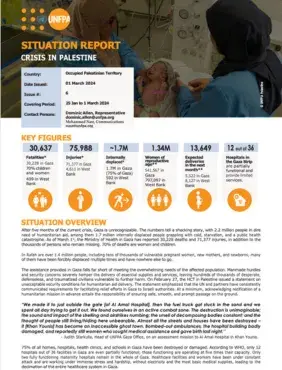After five months of the current crisis, Gaza is unrecognizable. The numbers tell a shocking story, with 2.2 million people in dire need of humanitarian aid, among them 1.7 million internally displaced people grappling with cold, starvation, and a public health catastrophe. As of March 1st, the Ministry of Health in Gaza has reported 30,228 deaths and 71,377 injuries, in addition to the thousands of persons who remain missing. 70% of deaths are women and children.
In Rafah are over 1.4 million people, including tens of thousands of vulnerable pregnant women, new mothers, and newborns, many of them have been forcibly displaced multiple times and have nowhere else to go.
The assistance provided in Gaza falls far short of meeting the overwhelming needs of the affected population. Manmade hurdles and security concerns severely hamper the delivery of essential supplies and services, leaving hundreds of thousands of desperate, defenseless, and traumatized civilians vulnerable to further harm. On February 27, the HCT in Palestine issued a statement on unacceptable security conditions for humanitarian aid delivery. The statement emphasized that the UN and partners have consistently communicated requirements for facilitating relief efforts in Gaza to Israeli authorities. At a minimum, acknowledging notification of a humanitarian mission in advance entails the responsibility of ensuring safe, smooth, and prompt passage on the ground.
“We made it to just outside the gate [of Al Amal Hospital], then the fuel truck got stuck in the sand and we spent all day trying to get it out. We found ourselves in an active combat zone. The destruction is unimaginable; the sound and impact of the shelling and airstrikes numbing; the smell of decomposing bodies constant; and the thought of people still living/hiding here unbearable. Almost all the streets and houses have been destroyed – it [Khan Younis] has become an inaccessible ghost town. Bombed-out ambulances, the hospital building badly damaged, and reportedly still women who sought medical assistance and gave birth last night.’’
- Judith Starkulla, Head of UNFPA Gaza Office, on an assessment mission to Al Amal Hospital in Khan Younis.
75% of all homes, hospitals, health clinics, and schools in Gaza have been destroyed or damaged. According to WHO, only 12 hospitals out of 36 facilities in Gaza are even partially functional; those functioning are operating at five times their capacity. Only two fully functioning maternity hospitals remain in the whole of Gaza. Healthcare facilities and workers have been under constant attack and are working under immense stress and hardship, without electricity and the most basic medical supplies, leading to the decimation of the entire healthcare system in Gaza.


